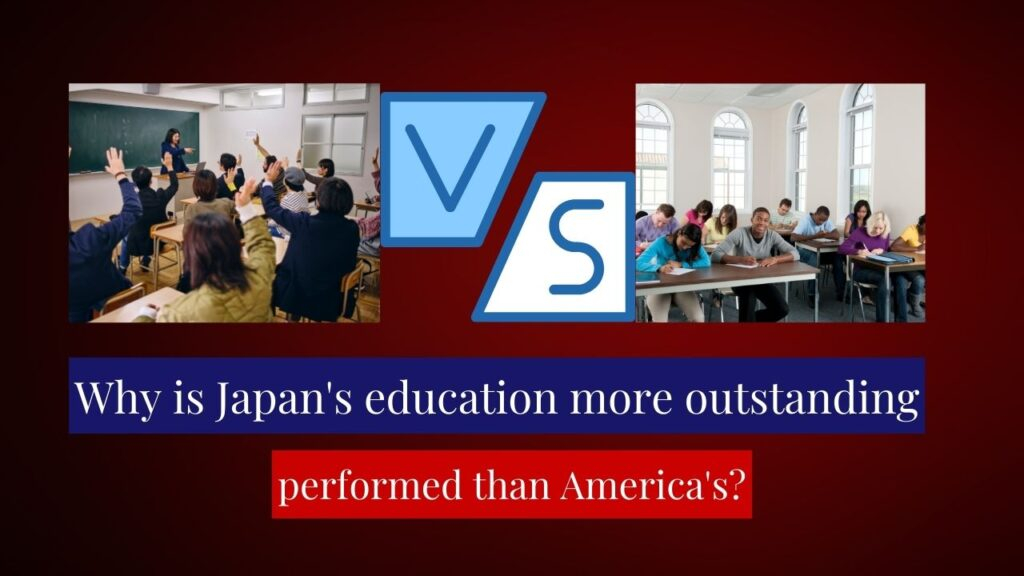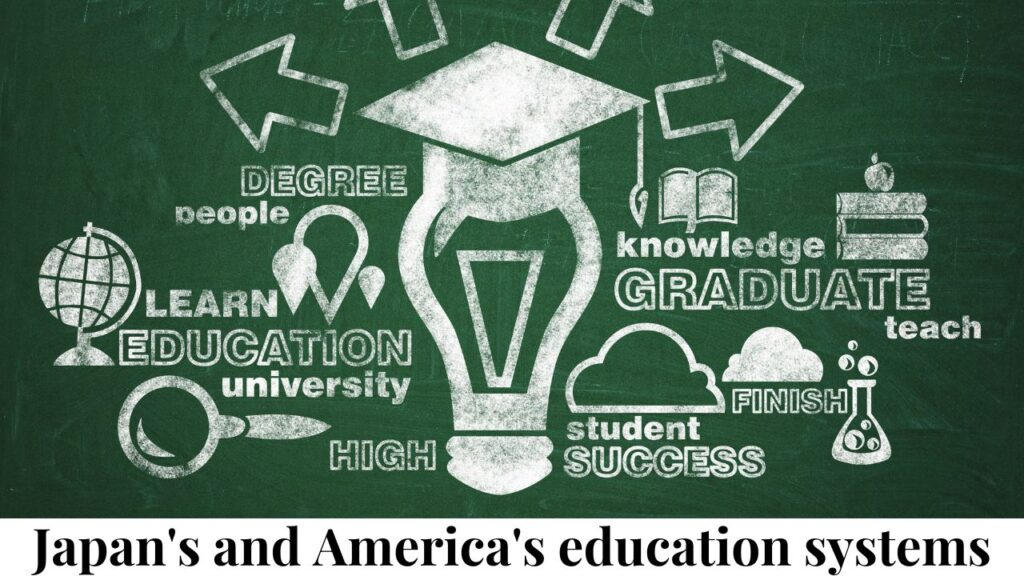Why is Japan's education more outstanding performed than America's?

Do you know that Japan’s students have more outstanding results than Americans in OSED scores? Japan’s OECD score is 529, and America’s OECD score is 531. This gives a clear idea that Japan is better than America in terms of education. Japan’s teachers make the most contribution to making Japan’s students generous.
There are many reasons for improving higher education in the country. One of the reasons is education at a low cost. Between Japan and the US, the average tuition fee at a Japanese university is 653,367 BDT, and the US tuition fee is 3,356,414 BDT. Moreover, Student improvement, academic standards, and the creation of moral values in teachers have become central shields for Japanese education. For more information regarding this article, you should read it.
Japan's and America's education systems

Japan
Japanese schools are very advanced. Students get every instrument of study from schools. The country’s teachers place a lot of emphasis on the quality of education. As a result, Japan has placed among the top nations on the OECD list. The Japanese academic year starts in April. Let’s take a look at Japan’s school level.
Primary school: Japanese children start education at three years old. They study in kindergarten or nursery. The time duration of primary school is six years. They learn from schools,
- moral education, special activities, human relations, language, math, environment, and health.
Secondary school: Secondary school is the period from lower secondary to upper secondary. It covers grades 7 to 12 and lasts up to 6 years. A student at Sechandarya School learns a subject.
- Mathematics, social studies, Japanese language, science, and English
Higher school: In Japan, the university level is familiar as the higher school level. Duration is from 2 to 4 years. While studying at university, students acquire knowledge of a specific subject, such as
- Engineers
- Doctor
- Researcher also others
America
American law requires every student to receive an education. The education system of the country is divided into three levels, as detailed below:
Primary Education: Primary school consists of kindergarten and elementary school. Students start at the primary level at age five and can complete it at age 10. In elementary school, children learn many subjects from a single teacher. They know in schools.
- writing, math skills, reading, critical thinking, and solving other problems.
Middle school: The middle school covers the period from grades 6 to 8. Students aged 11 to 13 attend middle school. In middle schools, students receive different lessons from different teachers, such as
- English: (Grammar, spelling, and sentence structure)
- Mathematics: (fractions, equations, Decimals, and percents)
- Science: (earth science, basic biology, basic chemistry, and basic physics)
- Social studies: (civics, economics, and government)
Higher school: Between the ages of 14 to 18, they complete high school. The 9th to 12th class is called high school. Students learn in high school.
- English: ( classic literature, essay, writing, and different analysis)
- Mathematics: ( algebra, geometry, and calculus)
- Science: ( biology, chemistry, and physics) gain deep knowledge.
- Social studies: ( US history, world history, environment and civics)

For an Inquiry about Japan: (880) 1930-350350
Which one is more efficient in education between Japan and America

Japan
Since World War II, Japan has been improving its education. In Japan, education allows the Law. Japan ranks 27th in the world for its education. Japanese students learn morals from families as well as from schools. Every student in Japan has vast knowledge. Japanese schools have many facilities and activities, such as:
- Each class has 30 students. So, the classes create a very peaceful environment.
- The signature rate within the country is 100%.
- Each student averages 8 hours for homework, Gives time.
- To motivate students to do their work, students are divided into small groups and clean the school’s classroom, garden area, and washroom.
- They have their lunch with their teachers.
- Japan is among the top countries ranked in math and science.
- Japan has more private schools than other developing countries.
- Japan has legally implemented compulsory education. Its durability is up to 9 years.
- Japan has a 98% graduation rate, Which is the highest rate in high school in the world.
- The GDP value of the education and science sector in Japan in the year 2023 was 5.42 trillion.
America
America is the country of emotions for international students. Every work in America has a touch of modernity. At the same time, education has improved. The number of international students seeking education in the last year, 2022-2023, stood at 1,057,188. The reason for this large number of people to study in America is their education system and facilities. Let’s not have these things.
- The rate of education in America is 92%. And the remaining 8% are illiterate. Middle school classes are consisting of 18-20 students.
- Students usually devote 5 hours per day.
- America spent 5.44% of its GDP on education.
- America ranks 31st to 38th in the OECD rankings.
The role of teachers in Japan's and American education system
Japan
To become a public school teacher in Japan, you must have a bachelor’s degree from a Ministry-approved university. Then, if you specialized in a subject for school teaching, it would help. A course requires one to take before teaching. A 2-year course is necessary for teachers who want to teach in junior schools. A 4-year course is also crucial for those who wish to become a university teacher. Japanese teachers put a lot of effort into the future of their students. Teaching is the top priority of 82% of Japanese teachers. The teaching profession enjoys elite status and respect in the country. The reason is the hard work of teachers towards their students.
Japanese students have demonstrated exceptional academic performance, with 8% achieving Level 2 proficiency in the OECD and 23% scoring outstanding in mathematics. These results have positioned Japan at level 5 or 6 in the PISA mathematics test. The OECD average score for literacy, math, and science in Japan is 529, reflecting the high quality of education in the country.
America
Those who want to teach in elementary schools usually need a bachelor’s degree. And secondary school teachers earn a bachelor’s degree in a subject. Licensing of all public school teachers is mandatory. Before teaching in schools, teachers have to participate in a teaching program for 1 or 2 years. All public school teachers must meet the public school teacher requirements for math and science subjects. Sometimes, teachers are required to earn a master’s degree to maintain licensure. The NCLB Act of 2002 in America requires all teachers to be highly qualified.
Curriculum and teaching methods in Japan and America
Japan
Japanese students pay a lot of attention to the curriculum. The country’s curriculum includes ethics, special activities, and compulsory subjects. Compulsory subjects include Japanese language, mathematics, social studies, music, art, science, handicrafts, and physical education. Moral education is about being compassionate towards each other and preserving the environment. And follow society’s rules and learn to control yourself. Special activities refer to doing various extra-curricular activities in groups within the class. These curricula enhance their skills. As such, it allows a child to learn and think independently. Also, it helps children acquire skills.
America
In America, attention is paid to the curriculum of students. However, American educational institutions do not teach morals to students. As a result, students lead prosperous lives. Students are generally attentive to understanding math, arts, science, and US history. Students are involved in extracurricular activities like sports, clubs, and arts programs.
The emphasis on discipline and respect in Japanese and American school
Japan
Discipline is a fundamental value in Japan. Each Japanese student has to follow discipline. Students wear uniforms while attending school. This follows the discipline of the school. Japanese students learn from an early age to clean their institutions. This makes them responsible and dutiful.
Japanese teachers are very friendly with students. They lead their student to maintain rules and regulations. Teachers play an essential role in students’ academic development, character building, and instilling values.
America
Americans don’t have discipline. Americans tend to be arrogant. They can’t learn this education in their educational institutions. Even they do not achieve this education from their family. The causes of lack of discipline in the students. The student’s lack of respect for the teacher, arguments, abuse with the teacher, and inappropriate behavior of students in school. These are why students disrupt learning in America. As a result, only 25% of American children attend public schools.
Which education system treats its students better
Between Japan and America, Japan’s education is better. Japanese students tend to be polite, well-mannered, and hard-working, which does not show American students. Japanese students are among the top performers internationally in math exams. But every year follows that more international students go to America than Japan. Japan is an idol for education in all aspects. Statistics show that 95% of Japanese students complete a bachelor’s degree, and the American rate is 89%.
Conclusion
The article will give you a detailed idea. Japanese education is currently gaining popularity. However, one problem with Japan’s education system is that excessive pressure leads to high suicide rates among 14-—to 16-year-olds. However, as most students are used to the pressure of education from a young age, they grow up in a better position than other countries.